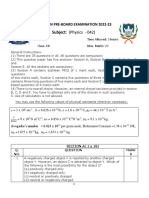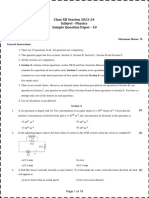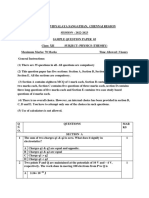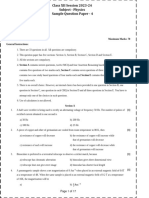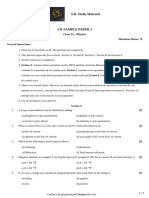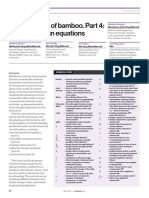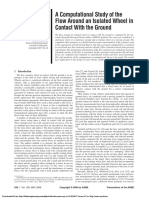Class XII Session 2024-25
Subject - Physics
Sample Question Paper - 2
Time Allowed: 3 hours Maximum Marks: 70
General Instructions:
1. There are 33 questions in all. All questions are compulsory.
2. This question paper has five sections: Section A, Section B, Section C, Section D and Section E.
3. All the sections are compulsory.
4. Section A contains sixteen questions, twelve MCQ and four Assertion Reasoning based of 1 mark each, Section B
contains five questions of two marks each, Section C contains seven questions of three marks each, Section D
contains two case study based questions of four marks each and Section E contains three long answer questions of
five marks each.
5. There is no overall choice. However, an internal choice has been provided in one question in Section B, one
question in Section C, one question in each CBQ in Section D and all three questions in Section E. You have to
attempt only one of the choices in such questions.
6. Use of calculators is not allowed.
Section A
1. C and Si both have the same lattice structure, having 4 bonding electrons in each. However, C is an insulator [1]
whereas Si is an intrinsic semiconductor. This is because
A. In case of C the valence band is not completely filled at absolute zero temperature.
B. In case of C the conduction band is partly filled even at absolute zero temperature.
C. The four bonding electrons in the case of C lie in the second orbit, whereas in the case of Si they lie in the
third.
D. The four bonding electrons in the case of C lie in the third orbit, whereas for Si they lie in the fourth orbit.
a) Option B b) Option A
c) Option D d) Option C
2. According to Joule's law, if potential difference across a conductor of material of resistivity ρ remains constant, [1]
then heat produced in the conductor is directly proportional to
a) ρ b)
1
√ρ
c) ρ −1
d) 2
ρ
3. An astronomical telescope of ten fold angular magnification has a length of 44 cm. The focal length of the [1]
objective is
a) 44 cm b) 440 cm
Page 1 of 19
� c) 4 cm d) 40 cm
4. Time period of oscillation of a magnetic needle is [1]
−−− −−−
a) T = √
I
b) T = π√
MB
MB I
−−− −−−
c) T = 2π√
MB
d) T = 2π√
I
I MB
5. The electrostatic force between the metal plates of an isolated parallel capacitor C having a charge Q and area A [1]
is:
a) independent of the distance between the b) inversely proportional to the distance
plates between the plates
c) proportional to the square root of the d) linearly proportional to the distance between
distance between the plates the plates
6. A galvanometer of resistance 25Ω is shunted by a 2.5Ω wire. The part of total current Io that flows through the [1]
galvanometer is given by
a) I
I0
=
2
11
b) I0
I
=
4
11
c) d)
I 1 I 3
= =
I0 11 I0 11
7. Two coils have a mutual inductance 0.005 H. The current changes in the first coil according to equation I = I0 sin [1]
Ωt , where I0 = 10 A and ω = 100 π rad s-1. The maximum value of emf in the second coil is
a) 12 π b) 2 π
c) 5 π d) 6 π
χ
8. The susceptibility of a paramagnetic material is χ at 27° C. At what temperature will its susceptibility be 2
? [1]
a) 54° C b) 327° C
c) 237° C d) 1600° C
9. Consider sunlight incident on a slit of width 104 A. The image seen through the slit shall [1]
a) only be a diffused slit white in colour b) a bright slit white at the center diffusing to
regions of different colours
c) a bright slit white at the center diffusing to d) be a fine sharp slit white in colour at the
zero intensities at the edges center
10. Point charges +4q, -q and +4q are kept on the X-axis at points x = 0, x = a and x = 2a respectively: [1]
a) all the charges are in unstable equilibrium b) all the charges are in stable equilibrium
c) none of the charges is in equilibrium d) only - q is in stable equilibrium
11. The given circuit has two ideal diodes connected as shown in the figure below. The current flowing through the [1]
resistance R1 will be
a) 2.5 A b) 10.0 A
Page 2 of 19
� c) 1.43 A d) 3.13 A
12. Which of the following principle is used in optical fibre? [1]
a) Total internal reflection b) Scattering
c) Interference d) Diffraction
13. Assertion (A): If a proton and electron are moving with same velocity, then wavelength of de-Broglie wave [1]
associated with electron is longer than that associated with proton.
Reason (R): The wavelength of de-Broglie wave associated with a moving particle is inversely proportional to
its mass.
a) Both A and R are true and R is the correct b) Both A and R are true but R is not the
explanation of A. correct explanation of A.
c) A is true but R is false. d) A is false but R is true.
14. Assertion: A parallel plate capacitor is connected across battery through a key. A dielectric slab of dielectric [1]
constant K is introduced between the plates. The energy which is stored becomes K times.
Reason: The surface density of charge on the plate remains constant or unchanged.
a) Assertion and reason both are correct b) Assertion and reason both are correct
statements and reason is correct explanation statements but reason is not correct
for assertion. explanation for assertion.
c) Assertion is correct statement but reason is d) Assertion is wrong statement but reason is
wrong statement. correct statement.
15. Assertion (A): In Young's double slit experiment the fringes become indistinct if one of the slits is covered with [1]
cellophane paper.
Reason (R): The cellophane paper decreases the wavelength of light.
a) Both A and R are true and R is the correct b) Both A and R are true but R is not the
explanation of A. correct explanation of A.
c) A is true but R is false. d) A is false but R is true.
16. Assertion (A): A bulb connected in series with a solenoid is connected to ac source. If a soft iron core is [1]
introduced in the solenoid, the bulb will glow brighter.
Reason (R): On introducing soft iron core in the solenoid, the inductance increases.
a) Both A and R are true and R is the correct b) Both A and R are true but R is not the
explanation of A. correct explanation of A.
c) A is true but R is false. d) A is false but R is true.
Section B
17. Arrange the following electromagnetic waves in the order of their increasing wavelength : [2]
a. γ -rays
b. Microwaves
c. X-rays
d. Radio waves
How are infra-red waves produced? What role does infra-red radiation play in
i. maintaining the Earth's warmth and
Page 3 of 19
� ii. physical therapy?
18. The coercivity of a certain permanent magnet is 4.0 × 104 Am-1. This magnet is placed inside a solenoid 15 cm [2]
long and having 600 turns and a current is passed in the solenoid to demangnetise it completely. Find the current.
19. Explain the formation of the barrier potential in a p-n junction. [2]
20. Write the shortcomings of Rutherford atomic model. Explain how these were overcome by the postulates of [2]
Bohr's atomic model.
21. A galvanometer has a resistance of 8Ω . It gives a full scale deflection for a current of 10 mA. It is to be [2]
converted into an ammeter of range 5 A. The only shunt resistance available is of 0.02 Ω , which is not suitable
for this conversion. Find the value of resistance R that must be connected in series with the galvanometer (Fig.)
to get ammeter of desired range.
OR
a. State Ampere's circuital law connecting the line integral of B over a closed path to the net current crossing the
area bounded by the path.
b. Use Ampere's law to derive the formula for the magnetic field due to an infinitely long straight current carrying
wire.
c. Explain carefully why the derivation as in (b) is not valid for magnetic field in a plane normal to a current-
carrying straight wire of finite length and passing through the midpoint of the axis.
Section C
22. In Figure, ε and ε are respectively 2.0 V and 4.0 V and the resistances r1, r2 and R are respectively 1.0 Ω , 2.0
1 2
[3]
Ω and 5.0 Ω . Calculate the current in the circuit. Also, calculate:
i. potential difference between the points b and a,
ii. potential difference between a and c.
23. Explain, with the help of a circuit diagram, how the thickness of depletion layer in a p-n junction diode changes [3]
when it is forward biased. In the following circuits which one of the two diodes is forward biased and which is
reverse biased?
i.
ii.
24. The data given below gives the photon energy (in eV) for a number of waves whose wavelength values (in nm) [3]
are also given.
Wavelength (in nm) → 200 400 600 800 1000 1200
Page 4 of 19
� Photon energy (in eV) → 6.216 3.108 2.072 1.554 1.243 1.036
(Without doing any calculation/taking any reading), explain how one can use this data to draw an appropriate
graph to infer
a. photon energy corresponding to a wavelength of 100 nm.
b. the wavelength value (in nm) corresponding to a photon energy of 1 eV.
c. velocity of light, assuming that the value of Planck's constant is known.
25. Draw a graph showing the variation of binding energy per nucleon with mass number of different nuclei. Write [3]
any two salient features of the curve. How does this curve explain the release of energy both in the processes of
nuclear fission and fusion?
26. i. Using Bohr's second postulate of quantisation of orbital angular momentum show that the circumference of [3]
the electron in the nth orbital state in hydrogen atom is n-times the de-Broglie wavelength associated with it.
ii. The electron in hydrogen atom is initially in the third excited state. What is the maximum number of spectral
lines which can be emitted when it finally moves to the ground state?
27. In a diffraction pattern due to a single slit, how will the angular width of central maximum change, if [3]
a. Orange light is used in place of green light,
b. the screen is moved closer to the slit,
c. the slit width is decreased?
Justify your answer in each case.
28. i. Define the term self-inductance and write its S.I. unit. [3]
ii. Obtain the expression for the mutual inductance of two long co-axial solenoids S1 and S2 wound one over
the other, each of length L and radii r1 and r2 and n1 and n2 number of turns per unit length, when a current I
is set up in the outer solenoid S2.
OR
i. Will the earth's magnetic field induce current in an artificial satellite with a metal surface that is in orbit around
the equator? Around the poles?
ii. If so how would these currents affect the motion of the satellite?
Section D
29. Read the text carefully and answer the questions: [4]
LASER: Electromagnetic radiation is a natural phenomenon found in almost all areas of daily life, from radio
waves to sunlight to x-rays. Laser radiation - like all light - is also a form of electromagnetic radiation.
Electromagnetic radiation that has a wavelength between 380 nm and 780 nm is visible to the human eye and is
commonly referred to as light. At wavelengths longer than 780 nm, optical radiation is termed infrared (IR) and
is invisible to the eye. At wavelengths shorter than 380 nm, optical radiation is termed ultraviolet (UV) and is
also invisible to the eye. The term laser light refers to a much broader range of the electromagnetic spectrum
that just the visible spectrum, anything between 150 nm up to 11000 nm (i.e., from the UV up to the far IR). The
term laser is an acronym which stands for light amplification by stimulated emission of radiation. Einstein
explained the stimulated emission. In an atom, electron may move to higher energy level by absorbing a photon.
When the electron comes back to the lower energy level it releases the same photon. This is called spontaneous
emission. This may also so happen that the excited electron absorbs another photon, releases two photons and
returns to the lower energy state. This is known as stimulated emission.
Laser emission is therefore a light emission whose energy is used, in lithotripsy, for targeting and ablating the
Page 5 of 19
� stone inside human body organ.
Apart from medical usage, laser is used for optical disk drive, printer, barcode reader etc.
(a) What is the full form of LASER?
a) light amplification by simultaneous b) light amplified by synchronous
emission of radiation emission of radiation
c) light amplified by stimulated emission d) light amplification by stimulated
of radiation emission of radiation
(b) The stimulated emission is the process of
a) absorption of two photon when electron b) release of two photons by absorbing
moves from lower to higher energy one photon when electron comes back
level from higher to lower energy level
c) release of a photon when electron d) absorption of a photon when electron
comes back from higher to lower energy moves from lower to higher energy
level level
(c) What is the range of amplitude of LASER?
a) 150 nm - 400 nm b) 700 nm - 11000 nm
c) Both 150 nm - 400 nm and 700 nm - d) 800 nm - 12000 nm
11000 nm
OR
LASER is used in
a) Ionization b) Transmitting Satellite signal
c) Optical disk drive d) Radio communication
(d) Lithotripsy is
a) Laboratory application b) An industrial application
c) A medical application d) Process control application
30. Read the text carefully and answer the questions: [4]
In 1909, Robert Millikan was the first to find the charge of an electron in his now-famous oil-drop experiment.
In that experiment, tiny oil drops were sprayed into a uniform electric field between a horizontal pair of
oppositely charged plates. The drops were observed with a magnifying eyepiece, and the electric field was
adjusted so that the upward force on some negatively charged oil drops was just sufficient to balance the
downward force of gravity. That is, when suspended, upward force qE just equaled Mg. Millikan accurately
measured the charges on many oil drops and found the values to be whole number multiples of 1.6 × 10-19 C
Page 6 of 19
� the charge of the electron. For this, he won the Nobel prize.
(a) If a drop of mass 1.08 × 10-14 kg remains stationary in an electric field of 1.68 × 105 NC-1, then the
charge of this drop is
a) 6.40 × 10-19 C b) 4.8 × 10-19 C
c) 3.2 × 10-19 C d) 1.6 × 10-19 C
(b) Extra electrons on this particular oil drop (given the presently known charge of the electron) are
a) 4 b) 5
c) 8 d) 3
(c) A negatively charged oil drop is prevented from falling under gravity by applying a vertical electric field
100 V m-1. If the mass of the drop is 1.6 × 10-3 g, the number of electrons carried by the drop is (g = 10
ms-2)
a) 109 b) 1018
c) 1012 d) 1015
(d) The important conclusion given by Millikan's experiment about the charge is
a) charge has no definite value b) charge is quantized
c) charge is never quantized d) charge on oil drop always increases
OR
If in Millikan's oil drop experiment, charges on drops are found to be 8μC, 12μC, 20μC , then quanta of
charge is
a) 20μ C b) 12μ C
c) 8μ C d) 4μ C
Section E
31. Determine the 'effective focal length' of the combination of the two lenses having focal lengths 30 cm and -20cm [5]
if they are placed 8.0 cm apart with their principal axes coincident. Does the answer depend on which side of the
combination a beam of parallel light is incident? Is the notion of effective focal length of this system useful at
all?
OR
Give the shape of interference fringes observed
a. in a Young's double-slit experiment
b. in the air wedge experiment
c. in the Lloyd's mirror experiment
Page 7 of 19
� d. when a small lamp is placed before a thin mica sheet and light waves reflected from the front and back surfaces of
the sheet combine to produce interference pattern on a screen behind the lamp. (Pohl's experiment)
e. from a thin air film formed by placing a convex lens on top of a flat glass plate (Newton's arrangement).
32. a. Derive an expression for the energy stored in a parallel plate capacitor of capacitance C when charged up to [5]
voltage V. How is this energy stored in the capacitor?
b. A capacitor of capacitance 1 μ F is charged by connecting a battery of negligible internal resistance and emf
10 V across it. Calculate the amount of charge supplied by the battery in charging the capacitor fully.
OR
Derive an expression for equivalent capacitance of three capacitors when connected
i. in series and
ii. in parallel.
33. An emf ε = 100 sin 314 t is applied across a pure capacitor of 637 μ F. Find [5]
i. the instantaneous current I
ii. instantaneous power P
iii. the frequency of power and
iv. the maximum energy stored in the capacitor.
OR
A circuit containing a 80 mH inductor and a 60 μF capacitor in series is connected to a 230 V, 50 Hz supply. The
resistance of the circuit is negligible.
a. Obtain the current amplitude and rms values.
b. Obtain the rms values of potential drops across each element.
c. What is the average power transferred to the inductor?
d. What is the average power transferred to the capacitor?
e. What is the total average power absorbed by the circuit? [‘Average’ implies ‘averaged over one cycle’.]
Page 8 of 19



